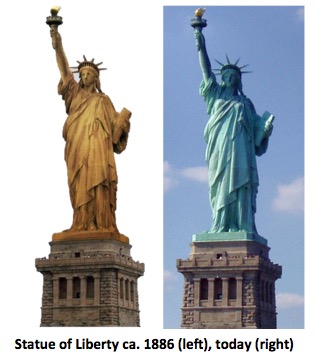Have you ever stood at the foot of Lady Liberty, gazing up at her weathered green exterior, and wondered what she might have looked like when she first arrived in New York Harbor? The iconic copper statue, a symbol of freedom and hope for millions, has become synonymous with a deep, verdant hue. But did you know that she wasn’t always this way? The Statue of Liberty’s journey from a gleaming, coppery newcomer to her familiar green patina is a tale full of surprises and scientific intrigue. Join us as we unveil the secrets behind the Lady’s stunning color transformation and explore the fascinating factors that have shaped her appearance over time.

Image: 9gag.com
Imagine, if you will, a gleaming new penny—that’s what the Statue of Liberty looked like when she first arrived in 1886. The copper sheets that made up her skin shimmered in the sunlight, a bright and striking sight against the backdrop of the bustling harbor. But over time, a fascinating chemical reaction began to take place, slowly transforming the copper into the green patina we know and love today. This process, known as oxidation, is a natural phenomenon that occurs when copper reacts with the elements, particularly oxygen and moisture in the air. The green patina, officially called “copper hydroxide carbonate,” serves as a protective layer, shielding the underlying copper from further corrosion and preserving the statue’s structural integrity.
The Transformation Begins: From Copper Gleam to Emerald Green
The transition from shiny copper to verdant green was gradual, occurring over decades. The process began as the copper sheets were exposed to the elements, particularly the salt-laden air of New York Harbor. The first signs of change were subtle, a faint patina appearing on the surface over time. But as decades passed, the patina thickened, deepening in color from a pale blue-green to a rich, emerald hue. It’s a testament to the power of nature’s artistry.
Beyond the Green: Understanding the Science
This mesmerizing color transformation isn’t just aesthetically pleasing; it’s a crucial part of the Statue of Liberty’s preservation. To understand it fully, let’s take a closer look at the science behind the patina’s formation.
-
The Role of Oxygen: Copper, a naturally reactive metal, readily combines with oxygen in the air, forming what’s known as copper oxide. This reaction, similar to what happens when iron rusts, starts the patina-forming process.
-
The Influence of Water: Water, particularly when mixed with impurities like salt from the air and sea, further enhances the oxidation process. This combination creates a more complex reaction, leading to the formation of copper hydroxides, which are the primary components of the green patina.
-
The Presence of Carbon Dioxide: Carbon dioxide in the air further reacts with the copper hydroxides, forming copper carbonates. These compounds contribute to the distinctive green hue and the patina’s protective qualities.
The Patina’s Protective Shield: A Gift from Nature
The green patina, while aesthetically pleasing, plays a vital role in ensuring the Statue of Liberty’s longevity. Here’s why:
-
Corrosion Resistance: The patina acts like a protective barrier, shielding the underlying copper from further corrosion. It prevents the copper from reacting further with the elements, mitigating the damage that could lead to weakening and deterioration.
-
Structural Integrity: The patina helps maintain the structural integrity of the statue. By preventing further corrosion, it ensures the copper sheets remain strong and stable, able to withstand the forces of nature.
-
A Beautiful Legacy: The patina not only protects the statue but also enhances its beauty and historical significance. It reflects the passage of time, the natural forces that have sculpted its surface, and the enduring story of Lady Liberty.

Image: ar.inspiredpencil.com
What Color Was The Statue Of Liberty Originally
A Timeless Treasure: Unveiling the Statue’s Past and Future
The Statue of Liberty’s green patina is more than just a color; it’s a symbol of resilience, a testament to the power of nature, and a reminder of the enduring legacy of this iconic landmark. Understanding the science behind the patina’s formation allows us to appreciate the meticulous care that goes into preserving Lady Liberty. The next time you stand at the foot of this magnificent statue, take a moment to appreciate the intricate story etched onto her surface, a story that unfolds in the vibrant hues of green, a reminder of the Statue’s past, present, and enduring future.






